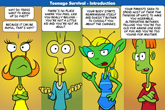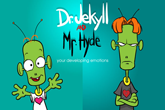Stressed rats keep returning to cannabis and scientists know why
Rats with naturally high stress levels were far more likely to self-administer cannabis when given access. Behavioral testing showed that baseline stress hormones were the strongest predictor of cannabis-seeking behavior. Lower cognitive flexibility and low endocannabinoid levels also contributed to increased use. The results hint at possible early indicators of vulnerability to drug misuse.
Categories: Teen Health
Why ultra-processed foods make teens eat more when they aren’t hungry
A Virginia Tech study shows that ultra-processed foods may influence adolescents differently from slightly older young adults. Participants aged 18 to 21 ate more at a buffet and snacked even when not hungry after two weeks on an ultra-processed diet. Because eating without hunger predicts future weight gain, these findings hint at a heightened vulnerability during late adolescence.
Categories: Teen Health
Texas Teens Invent Device to Filter Microplastics from Water Supply
Microplastics, or tiny fragments of plastic worn away from the products we use and discard every day, are a common environmental problem. They’ve been found in the deepest oceans and on the highest mountain peaks, and in our bodies, too—researchers in Australia estimate that the average person swallows and breathes in a credit card’s worth of plastic every week. The health hazards of microplastics aren’t conclusive, but they’ve been linked to cancer, dementia, and reproductive disorders. And while there are ways to remove microplastics from the environment, these are generally expensive and can result in other types of pollutants.
Now, inspired by a visit to a water treatment plant and the realization that the U.S. Environmental Protection Agencey (EPA) doesn’t regulate microplastics, 17-year-olds Victoria Ou and Justin Huang of Woodlands, Texas, have invented an inexpensive, clean device that extracts microplastics from water. The process, which uses ultrasonic sound waves, is still being developed, but the pair are working to make it remove plastics from drinking water and industrial and residential wastewater. To help them continue their research, Ou and Huang won the Gordon E. Moore Award for Positive Outcomes for Future Generations, with a prize of $50,000.
Now, inspired by a visit to a water treatment plant and the realization that the U.S. Environmental Protection Agencey (EPA) doesn’t regulate microplastics, 17-year-olds Victoria Ou and Justin Huang of Woodlands, Texas, have invented an inexpensive, clean device that extracts microplastics from water. The process, which uses ultrasonic sound waves, is still being developed, but the pair are working to make it remove plastics from drinking water and industrial and residential wastewater. To help them continue their research, Ou and Huang won the Gordon E. Moore Award for Positive Outcomes for Future Generations, with a prize of $50,000.
Categories: Teen Health
A routine shingles shot may offer powerful defense against dementia
A unique vaccine rollout in Wales gave researchers an accidental natural experiment that revealed a striking reduction in dementia among seniors who received the shingles vaccine. The protective effect held steady across multiple analyses and was even stronger in women. Evidence also suggests benefits for people who already have dementia, hinting at a therapeutic effect.
Categories: Teen Health
Scientists reveal what really drives the “freshman 15”
College life creates a perfect storm for overeating, as students consume more calories when surrounded by friends, eating in dining halls, or following unstructured schedules. A four-week study using a mobile app revealed that students often underestimate how much they eat, especially in social or formal dining settings. Emotional influences, gender differences, and environmental cues all contribute to this subtle but consistent rise in intake.
Categories: Teen Health
Doctors are seeing more aggressive breast cancer in younger women than expected
Younger women are being diagnosed with breast cancer more often than screening guidelines anticipate. Many of these cancers are invasive and harder to treat, especially in those under 40. After analyzing 11 years of data, researchers found that this age group makes up a steady and significant share of diagnoses. The results support a stronger push for earlier risk evaluation.
Categories: Teen Health
California Law Lowers the Volume on Streaming Service Ads
A law signed by California Governor Gavin Newsom in October aims to put a stop to excessively loud advertisements on streaming services like Hulu, Netflix, and Amazon Prime in the state. The law is a response to these platforms airing commercials at a louder volume than the shows and movies during which they play, as well as a corresponding “troubling jump” in ad noise complaints received by the Federal Communications Commission (FCC). The streaming services are required to implement the ad volume limits by July 2026.
Data from the U.S. Centers for Disease Control and Prevention (CDC) estimates that 12.5 percent of U.S. children and teens have been diagnosed with some form of noise-related hearing loss. But how loud is too loud? According to the World Health Organization (WHO), the loudest you should ever play a personal audio device is 75 decibels, or no more than 60 percent of its maximum volume.
Data from the U.S. Centers for Disease Control and Prevention (CDC) estimates that 12.5 percent of U.S. children and teens have been diagnosed with some form of noise-related hearing loss. But how loud is too loud? According to the World Health Organization (WHO), the loudest you should ever play a personal audio device is 75 decibels, or no more than 60 percent of its maximum volume.
Categories: Teen Health
Simple thyroid check in pregnancy may lower autism risk
Researchers have found that ongoing thyroid hormone imbalance in pregnancy may be linked to higher autism risk in children. Treated thyroid disorders did not show the same effect. The longer the imbalance lasted across trimesters, the more the risk appeared to rise. The study underscores the need for consistent thyroid monitoring.
Categories: Teen Health
Millions are about to choose the wrong Medicare plan
Millions face Medicare decisions each year, but many don’t take advantage of tools that can save them money and stress. Insurance marketing often overshadows unbiased options like SHIP, leaving people unaware of better choices. Comparing real costs—not just premiums—can prevent unpleasant surprises, especially when provider networks or drug rules change. New assistance programs for low-income adults offer valuable help for 2026.
Categories: Teen Health
A popular “essential” medicine may be putting unborn babies at risk
A major review across 73 countries finds that access to antiseizure medications is rising, but safe prescribing isn’t keeping pace. Valproate—linked to serious birth defects—remains widely used in many regions despite WHO warnings. Limited access to newer drugs means millions may still be at risk. Researchers urge global education and stronger safeguards.
Categories: Teen Health
A common nutrient deficiency may be silently harming young brains
Scientists studying young adults with obesity discovered early indicators of brain stress that resemble patterns seen in cognitive impairment. The group showed higher inflammation, signs of liver strain and elevated neurofilament light chain, a marker of neuron injury. Low choline levels appeared closely tied to these changes. The results hint that early metabolic disruptions may quietly influence the brain long before symptoms emerge.
Categories: Teen Health
Nearly 50 Years of the Great American Smokeout
November is lung cancer awareness month, and this year it coincides with almost fifty years of the American Cancer Society’s Great American Smokeout. First held in California on November 18, 1976, the initial Great American Smokeout helped nearly a million people quit smoking for the day. It continues to encourage people to stop smoking nearly a half-century later, emphasizing the resources available to help them quit for good.
According to the U.S. Centers for Disease Control and Prevention (CDC), cigarette smoking among U.S. adults has dropped by almost two-thirds in that time, and among current smokers nearly 70 percent want to quit and about half have made an effort to do so in the past year. This is good news, but almost 35 million American adults still smoke, and lung cancer remains the leading cause of cancer deaths in the United States and Canada. Even more alarming, research shows an increase in lung cancer diagnoses among people under age fifty, especially those who have never smoked. There could hardly be a better reminder that, if you smoke or know someone who does, it’s never too early to stop.
According to the U.S. Centers for Disease Control and Prevention (CDC), cigarette smoking among U.S. adults has dropped by almost two-thirds in that time, and among current smokers nearly 70 percent want to quit and about half have made an effort to do so in the past year. This is good news, but almost 35 million American adults still smoke, and lung cancer remains the leading cause of cancer deaths in the United States and Canada. Even more alarming, research shows an increase in lung cancer diagnoses among people under age fifty, especially those who have never smoked. There could hardly be a better reminder that, if you smoke or know someone who does, it’s never too early to stop.
Categories: Teen Health
Just a few cigarettes a day can damage your heart for decades
People who smoke only a couple of cigarettes a day still face surprisingly high risks of heart problems and early death. A large review of long-term studies shows that even very light smokers can see their risk of heart failure climb sharply. While quitting leads to major health improvements, some risk remains for decades. The safest approach is quitting entirely, especially at younger ages.
Categories: Teen Health
Scientists reverse kidney damage in mice, hope for humans next
Researchers uncovered how fatty molecules called ceramides trigger acute kidney injury by damaging the mitochondria that power kidney cells. By altering ceramide metabolism or using a new drug candidate, the team was able to protect mitochondrial function and completely prevent kidney injury in mice.
Categories: Teen Health
Running on little sleep? You’re twice as likely to get hurt
Researchers found that runners who sleep poorly face nearly double the injury risk compared to those who rest well. The study highlights that sleep is not just recovery—it’s a key factor in preventing injuries. They stress that runners should prioritize rest alongside training. Simple habits like consistent bedtimes and limiting screens can make a big difference.
Categories: Teen Health
Georgia Teen Helps Fill the Gap Left by Lapse in SNAP Benefits
A teen in Gwinnett County, Georgia, has stepped up to help the people in his community who are impacted by the suspension of Supplemental Nutrition Assistance Program (SNAP) benefits caused by the ongoing government shutdown. Sixteen-year-old Jaeleon Hawkins-Jones of Snellville started a GoFundMe campaign in partnership with the Southeast Gwinnett Co-op Ministry to provide food boxes with rice, pasta, canned goods, cereal, peanut butter, and other essentials to affected residents. Jaeleon’s initial goal of $1,000 was quickly met and exceeded, so he plans to include gift cards recipients can use to put gas in their cars along with the food.
About 1.4 million people throughout Georgia receive SNAP benefits, and rely on the program to help them get enough to eat every month. As Jaeleon puts it, “When leadership fails to act, regular people like us have to step up.” Can you think of ways you could help your neighbors in need?
About 1.4 million people throughout Georgia receive SNAP benefits, and rely on the program to help them get enough to eat every month. As Jaeleon puts it, “When leadership fails to act, regular people like us have to step up.” Can you think of ways you could help your neighbors in need?
Categories: Teen Health
Scientists find brain chemical tied to trauma and depression
Researchers identified SGK1 as a key chemical connecting childhood trauma to depression and suicidal behavior. High SGK1 levels were found in the brains of suicide victims and in people with genetic variants linked to early adversity. Drugs that block SGK1 could offer a new kind of antidepressant, especially for patients resistant to SSRIs.
Categories: Teen Health
New research finds no clear link between acetaminophen (Tylenol) and autism
A sweeping review of existing studies finds no solid evidence that using acetaminophen (Tylenol) during pregnancy increases the risk of autism or ADHD in children. Researchers found that previous reviews often relied on weak or biased data, and most did not properly account for genetic or environmental factors shared by families. When these factors were considered, any apparent link between acetaminophen use and neurodevelopmental disorders largely disappeared.
Categories: Teen Health
Creating Deepfakes with AI Text-to-Video Apps Isn’t Worth the Risk
When generative artificial intelligence (AI) company OpenAI released its text-to-video app Sora 2 in September of this year, it promised that “you are in control of your likeness end-to-end” in its cameos—short clips featuring users’ likenesses made from facial scans. However, a company called Reality Defender that detects deepfakes claims it was able to bypass Sora’s security safeguards within 24 hours of release, creating cameos of celebrities and CEOs using publicly available footage from the Internet.
This is a reminder not just to be careful before you post photos and videos of yourself, your family, and friends online, but also that creating AI content comes with a heavy responsibility. You should always consider the potential impact of any AI-generated images and videos you make available, and ensure that your work respects the rights and dignity of others. Failure to do so can spread misinformation, damage reputations, harm individuals’ privacy, and erode the trust you’ve built online.
This is a reminder not just to be careful before you post photos and videos of yourself, your family, and friends online, but also that creating AI content comes with a heavy responsibility. You should always consider the potential impact of any AI-generated images and videos you make available, and ensure that your work respects the rights and dignity of others. Failure to do so can spread misinformation, damage reputations, harm individuals’ privacy, and erode the trust you’ve built online.
Categories: Teen Health
Scientists find hidden brain damage from a common pesticide
Prenatal exposure to the insecticide chlorpyrifos causes widespread brain abnormalities and poorer motor skills in children. Even after a residential ban, ongoing agricultural use continues to endanger developing brains.
Categories: Teen Health






